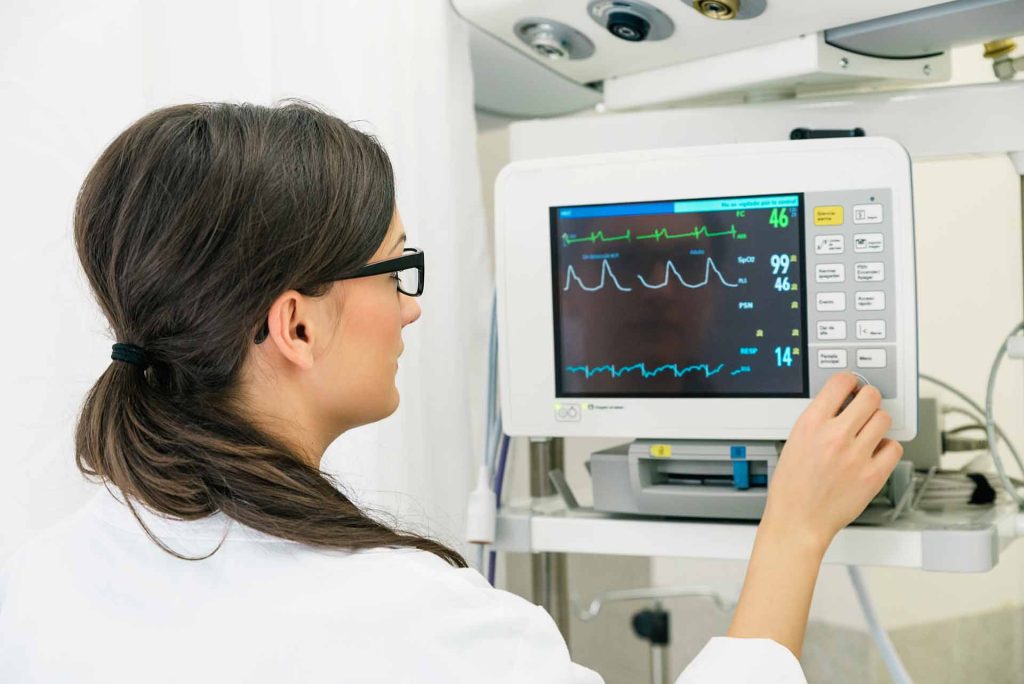Understanding the differences between Supraventricular Tachycardia (SVT) and Ventricular Tachycardia (VTach) can save lives. These rapid heart rhythms require distinct approaches under Advanced Cardiovascular Life Support protocols. Healthcare providers must recognize key distinctions to deliver appropriate emergency care.
Understanding SVT and VTach: Where They Originate
The primary distinction between SVT and VTach lies in where the abnormal rhythm begins within the heart. SVT develops in the heart’s atria, while VTach originates in the ventricles. This fundamental difference dramatically impacts both the severity of the condition and the treatment approach.
SVT encompasses various arrhythmias that start above the ventricular electrical conduction system. Classic Paroxysmal SVT has a narrow QRS complex and a very regular rhythm, with inverted P waves sometimes appearing after the QRS complex. Millions of people experience SVT annually, making it a relatively common clinical scenario.
VTach presents a more serious threat. Ventricular tachycardia is considered significant when there are three or more consecutive ventricular beats at a rate exceeding 100 beats per minute. This condition requires prompt assessment and immediate intervention.
SVT and VTach: Severity and Life-Threatening Potential
The danger level between these two tachycardias differs substantially. VTach is often life-threatening and can cause cardiac arrest and death, whereas SVT is rarely serious, with many cases resolving without treatment. Healthcare providers must approach each rhythm with appropriate urgency.
While SVT is rarely life-threatening or unstable, ventricular tachycardia is inherently unstable and can quickly degenerate into ventricular fibrillation. This progression makes VTach recognition and treatment critical in emergency settings.
VTach patients show more severe symptoms due to the arrhythmia’s location. Studies show that VTach can lead to a significant decrease in left ventricular ejection fraction compared to SVT. The reduced cardiac output compromises blood flow throughout the body.
ACLS Algorithm for SVT: Step-by-Step Treatment
The ACLS approach to SVT depends on patient stability. The main assessment involves determining whether the patient is stable or not, with signs of cardiovascular instability including hypotension, signs of shock or acute heart failure, altered mental status, or ischemic chest pain.
Stable SVT Management
For stable SVT patients with narrow QRS complexes, providers should attempt conservative measures first. If the patient with supraventricular tachycardia is stable and has a regular rhythm without a wide QRS complex, vagal maneuvers can be initiated as a first step.
When vagal maneuvers fail, medication becomes necessary. Adenosine is given as a rapid IV push, with the first dose being 6 mg followed by a normal saline flush, and a second dose of 12 mg IV if required. This medication proves highly effective for SVT conversion.
Alternative medications include beta-blockers and calcium channel blockers. These agents slow conduction through the atrioventricular node, controlling the rapid heart rate effectively.
Unstable SVT Treatment
Unstable SVT patients require immediate electrical therapy. Unstable patients with SVT and a pulse are always treated with synchronized cardioversion, with the appropriate voltage being 50-100 J. This energy level converts SVT efficiently without excessive force.
Before performing cardioversion, the healthcare provider should ensure the patient has IV access and equipment ready for suctioning, intubation, and measuring oxygen saturation. Proper preparation prevents complications during the procedure.
ACLS Algorithm for VTach: Critical Treatment Protocols
VTach management follows more aggressive protocols due to its life-threatening nature. The algorithm branches based on whether the patient has a pulse and their stability status.
Stable VTach with Pulse
For stable VTach patients, medication represents the initial approach. ACLS recommends antiarrhythmic drugs like amiodarone for stable VTach with a pulse. Amiodarone proves effective at controlling ventricular arrhythmias.
Antiarrhythmic infusions for stable wide-QRS include Procainamide, Amiodarone, or Sotalol IV, with Procainamide dosed at 20-50 mg/min until the arrhythmia is suppressed. Providers must monitor for hypotension and QRS widening during administration.
Amiodarone is given at 150mg IV over 10 minutes every 3-5 minutes, with a maximum of 2.2g in 24 hours. Following the initial dose, a maintenance infusion continues to prevent recurrence.
Unstable VTach with Pulse
Unstable VTach demands immediate electrical intervention. Synchronized cardioversion is indicated for unstable VTach with a pulse. This approach quickly restores normal rhythm before deterioration occurs.
For a wide and regular rhythm, use 100 Joules for synchronized cardioversion. Higher energy levels may be necessary if the first shock proves unsuccessful.
Pulseless VTach Management
Pulseless VTach follows the cardiac arrest algorithm. If the VTach is pulseless, follow the cardiac arrest algorithm with CPR and defibrillation. This rhythm requires immediate high-quality chest compressions and unsynchronized defibrillation.
If a pulse cannot be felt after palpating for up to 10 seconds, move immediately to the ACLS Cardiac Arrest, VTach, and VFib Algorithm. Time proves critical in these scenarios.
Key ECG Differences Between SVT and VTach
Electrocardiographic features help distinguish these rhythms. SVT originates above the heart’s lower chambers and typically shows narrow QRS complexes, while VTach starts in the ventricles and displays wide and abnormal QRS complexes.
Dissociated P waves and an A/V ratio less than 1 favor VTach, as does the presence of fusion beats and capture beats. These specific findings strongly suggest ventricular origin.
QRS duration provides additional clues. QRS duration more than 160 ms in left bundle branch block morphology or more than 140 ms in right bundle branch block morphology tachycardia favors VTach. Wider complexes typically indicate ventricular involvement.
When Diagnosis Remains Uncertain
Distinguishing SVT from VTach challenges even experienced providers. When initial care providers state whether a wide-complex tachycardia is ventricular or supraventricular, they are wrong in more than 50% of cases. This high error rate necessitates caution.
The safest approach involves assuming the worst-case scenario. When the diagnosis of SVT versus VTach is unclear, the patient should always be treated as if they have VTach, which is a life-threatening arrhythmia. This conservative strategy prevents dangerous treatment errors.
If a patient is pulseless, in shock, or in congestive heart failure, such rhythms should always be presumed to be VTach, with initial management proceeding under this presumption. Patient condition guides treatment decisions.
Cardioversion Energy Settings for SVT and VTach
Energy dosing differs between SVT and VTach cardioversion. Initial recommended doses for narrow regular rhythm (SVT) are 50-100 Joules biphasic or 100 Joules monophasic. These lower energies suffice for supraventricular rhythms.
For wide-complex regular rhythms such as VTach with a pulse, use 100 joules initially. If the first shock fails, providers should increase energy and deliver subsequent shocks.
Synchronized mode proves essential. An unsynchronized shock on a beating heart can trigger dangerous rhythms like ventricular fibrillation. Providers must verify synchronization before delivering cardioversion.
Medication Strategies: SVT and VTach Differences
Drug selection varies dramatically between these conditions. According to ACLS guidelines, the first drug of choice in stable tachycardia with a narrow QRS complex is adenosine. This rapid-acting medication specifically targets supraventricular rhythms.
Lidocaine is not an effective or appropriate treatment for SVT, and evidence does not support using lidocaine to discriminate between perfusing VTach and wide-complex tachycardia of uncertain origin. Proper medication selection prevents treatment failures.
For VTach, amiodarone remains the preferred antiarrhythmic. Its effectiveness at controlling ventricular arrhythmias makes it the standard first-line agent. Procainamide offers an alternative when amiodarone is contraindicated.
Understanding Causes: SVT and VTach Origins
The underlying causes differ significantly. VTach can be caused by coronary artery disease, hypertension, valvular heart disease, and cardiomyopathy. Structural heart disease frequently underlies ventricular arrhythmias.
SVT is usually caused by repetitive re-entry of electrical impulses proximally instead of propagating distally, and can result from premature beats, cardiac stimulants, thyroid conditions, valvular and coronary artery disease, and digoxin toxicity. Multiple factors can trigger supraventricular rhythms.
The most common cause of VTach is ischemic heart disease, referring to weakening of the heart muscle due to impaired blood flow. Previous heart attacks create scar tissue that promotes ventricular arrhythmias.
Clinical Implications and Patient Assessment
Rapid patient assessment determines the treatment pathway. Providers must quickly identify signs of instability, including hypotension, altered mental status, chest pain, and shock. These findings mandate immediate cardioversion regardless of rhythm type.
For stable patients, providers have time to attempt less invasive interventions. Vagal maneuvers and medications may successfully convert the rhythm without electrical therapy. However, continuous monitoring remains essential as deterioration can occur rapidly.
The 12-lead ECG provides valuable diagnostic information. Obtaining this before, during, and after treatment helps confirm the rhythm diagnosis and guides ongoing management. Expert consultation should be considered for complex cases.
Get Certified in Louisville: Master ACLS Protocols
Understanding SVT and VTach differences forms a crucial part of ACLS competency. Healthcare providers must master these algorithms to deliver life-saving care. Regular training and recertification ensure skills remain sharp during critical moments.
Ready to advance your emergency cardiac care skills? CPR Louisville, an American Heart Association training site, offers comprehensive ACLS certification and renewal courses. Their stress-free, hands-on classes provide the practical experience you need to confidently manage tachycardia emergencies.
Whether you need initial ACLS classes in Louisville or CPR certification in Louisville, their expert instructors guide you through real-world scenarios. They also offer BLS for Healthcare Providers, PALS, and CPR and First Aid courses. All training prepares you to recognize SVT and VTach quickly and respond appropriately.
Don’t wait until you face a critical cardiac emergency. Enroll in ACLS training today and gain the confidence to save lives. Contact CPR Louisville to schedule your certification course and master the essential algorithms that distinguish exceptional healthcare providers.
Frequently Asked Questions About SVT and VTach
What is the most important difference between SVT and VTach treatment protocols?
The most critical difference involves patient stability assessment and initial intervention. For unstable patients, both SVT and VTach require synchronized cardioversion, but energy settings differ. SVT uses 50-100 joules while VTach uses 100 joules initially. For stable patients, SVT responds to adenosine and vagal maneuvers, whereas VTach requires antiarrhythmic drugs like amiodarone. The key principle remains that VTach poses greater immediate danger and demands more aggressive treatment. When rhythm diagnosis remains uncertain, providers should always treat it as VTach to ensure patient safety.
Can you give adenosine for VTach?
Adenosine should not routinely be given for VTach. However, if VTach is stable, regular, and monomorphic with a wide QRS complex, adenosine may be considered cautiously. The primary risk involves worsening the rhythm or causing hemodynamic collapse. For irregular wide-complex tachycardia or pre-excited atrial fibrillation, adenosine is contraindicated and can prove dangerous. When rhythm diagnosis remains uncertain between VTach and SVT with aberrancy, providers should avoid adenosine and treat the rhythm as VTach with appropriate antiarrhythmic medications or cardioversion based on stability.
How can you tell the difference between SVT and VTach on a monitor?
Distinguishing SVT from VTach requires analyzing several ECG features. SVT typically shows narrow QRS complexes (less than 120 ms) with regular rhythm and heart rates between 150-250 beats per minute. VTach displays wide QRS complexes (greater than 120 ms) with three or more consecutive ventricular beats exceeding 100 bpm. Additional VTach indicators include AV dissociation, fusion beats, capture beats, QRS duration exceeding 160 ms, and northwest axis deviation. However, SVT with aberrant conduction can appear wide, making diagnosis challenging. When uncertainty exists, providers should always presume VTach and treat accordingly to prevent dangerous treatment errors.





